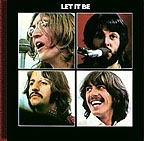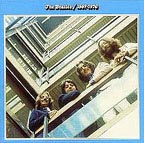|
Rock 'N Roll Case Study: GET BACK – The "lost" Beatles album
Regular readers of EAR CANDY have probably noticed that we have been promising an article about “Get Back” since October of 2002. But, with other interviews and articles, the story kept getting pushed to the back of the pile until March of 2003. So, it was quite ironic that Rolling Stone featured “Get Back-The Full Story Behind the Album That Never Was” in February of 2003. However, their article insists that the recently uncovered 500 tapes are unheard – true Beatle fans know that these have been available on a number of bootlegs since the ‘70s!
I. BEGINNINGS OF THE ALBUM
By 1968 the Beatles were in trouble. Their manager Brian Epstein had died; they had quit touring to become a studio-only band; they formed Apple records with a naive utopian vision and very little business sense. While The Beatles visit to the Maharishi in India injected new energy into the band, it was short lived. The resulting songs on the "White Album" and the "Hey Jude/Revolution" single. Tensions were high during the recording of the "White Album", in fact Ringo quit the band for a short time. II. THE CONCEPT/THE RECORDING
Paul's solution was for the group to "get back" to their roots, i.e. record their album like they used to without studio gimmicks and overdubs. Paul also wanted to Beatles to "get back" to playing live and a couple of locations were discussed (such as a Roman amphitheatre, or as Lennon sarcastically suggested, "an insane asylum"!) and it was originally agreed to film the rehearsals for a TV documentary. (It's interesting to note that Paul continued this theme with the original Wings!) Additionally, the songs written for 'Get Back' just weren't as strong as those from the 'White Album', perhaps resulting from the fact that the Beatles basically jumped right into their new project without having much time to write any new material. This time there was no luxury of a couple of months in India to compose the songs. However, the concept for 'Get Back' kept changing. The first incarnation of the project was to be a documentary of the Beatles at work on a new album. The project started on January 2nd 1969 at Twickenham Film Studio with tensions right from the start. The early morning filming schedule wasn't very productive for a band that was accustomed to late night recording at Abbey Road. At one point a bed was moved in for Yoko, whose presence merely aggravated an already tense situation. By mid-January the project was starting to collapse, with George Harrison leaving the group for a short time. Also, the location changed from the Twickenham Studios into the Apple Building. During the recording at the Apple building, Billy Preston was brought in as a supplemental keyboardist for the band. His presence helped ease tensions a little and the whole atmosphere was 'lighter' than the Twickenham sessions. Finally, a compromise on McCartney's original "live concert" concept was reached as the Beatles gave what was to be their last live performance on the roof of the Apple building for a noontime audience on January 30th. A total of 11 songs were performed at this "concert", which was captured on film. Also shown in the film was the havoc it wreaked on the local business district that day, with the police finally arriving to shut down the distraction. On the next day, January 31st 1969, the final Get Back recordings were held and the project was officially ended.
III. THE ORIGINAL LAYOUT OF THE "GET BACK" ALBUM
The Beatles had virtually washed their hands of the "Get Back" project - no one in the group had the heart to revisit and finish the project. Despite the bad feelings that had occurred, the Beatles once again rallied their forces for a "last hurrah" - starting their last album, "Abbey Road" in April of 1969. Meanwhile, Glyn Johns (the engineer and unaccredited producer from the "Get Back" sessions) assembled an album out of the material recorded in January. A bootleg resulted when some radio stations received "promotional copies" of "Get Back" in mid-1969. Here is the intended song lineup for the Glyn Johns album:
John Lennon supplied the album cover concept when he suggested a parody of the cover of their first album "Please Please Me". The Beatles were photographed in the exact same place they had posed 6 years earlier. With their longer hair and mustaches, the picture was intended to show that The Beatles had gone full circle from 1962. Although the photo did not adorn the cover of "Get Back" when the project fell through, it was eventually used as the cover of the 1933 compilation album, "The Beatles 1967-1970" (known as the 'blue' album). IV. WHAT HAPPENED?
During the time that the 'Get Back' project was on hold for a year, the Beatles actually broke up, this time John Lennon being the one to quit. However, John was persuaded to keep quiet about the dissolution of the group until new manager Allen Klein could re-negotiate their contract with Capitol. Meanwhile, Klein had decided to market the film as a full-length motion picture hoping to satisfy the Beatles film contract (they still owed one film). By this time nobody, especially the Beatles themselves wanted to touch the 'Get Back' project. So, Klein brought in legendary producer Phil Spector to piece an album together out of the virtual miles and miles of tape. Although Spector's "wall of sound" production might seem contrary to the original concept of "The Beatles As Nature Intended," Spector did an admirable job considering what he had to work with. Plus, his work must have pleased at least two Beatles, since Lennon and Harrison employed Spector well into the ‘70s as producer on solo albums. By this time, the title of the project had changed from "Get Back" (which had been released as a single in 1969) to "Let It Be".
V. FINAL RELEASE AS "LET IT BE"
Over a year after the original start date of "Get Back", the Beatles entered the studio for the very last time on January 3rd, 1970. The band (minus Lennon) recorded "I Me Mine", which had been featured in the film but not properly recorded. Phil Spector finished the re-production of the "Get Back" tapes on April 2nd and the album, "Let It Be" was released on May 8th. The film opened on May 13th with none of the Beatles in attendance. On April 10th, 1970 the Beatles official split up. While most of the songs on "Get Back" are on the "Let It Be" album, there are some notable differences. The following songs did not make it on "Let It Be":
Plus, the version of "'The Long And Winding Road" was originally intended to be un-orchestrated (more like the version on the "Anthology"). VI. PLANNED RELEASE OF THE ORIGINAL GET BACK?
Even 30+ years later, the "Get Back" project is still finding its way into the news. Paul McCartney himself even mentioned a possible official release of the original "Get Back" album. McCartney was talking about the "Let It Be" film adding, "You know what would be really cool? If we put the naked version of the record out as well. It's not announced or anything yet, but that's what's in the pipeline." Regarding the movie, Paul added that he wanted to "get the film remastered and everything, so it's all nice and clean and the sound's great." [BEATLEFAN Issue #136 May-June 2002] As if there weren't enough "Get Back" session bootlegs...On January 10, 2003 it was announced that police raids in England and the Netherlands had recovered what could be about 500 original Beatles' tapes that were stolen in the 1970s, including some never-released tracks from the "Get Back" sessions. However, these turned out NOT to be never-heard-before songs (well, they are still technically unreleased songs from the Get Back) but rather film crew reference tapes that have been much bootlegged before. On January 31, 2003 it was officially reported that the un-Spectorized version of "Let It Be" would be released in the fall of 2003. But curiously it was also reported that the album will have the same track listing as the "Let It Be" album that was released in 1970. This poses one problem - two of the tracks on the 1970 album were NOT recorded during the January 1969 sessions. These two songs, "Across the Universe" and "I Me Mine". Although it probably isn’t the real “Get Back” album, it will be interesting to see what will appear on the “revised Let It Be" album. The “Get Back” saga continues…
|


